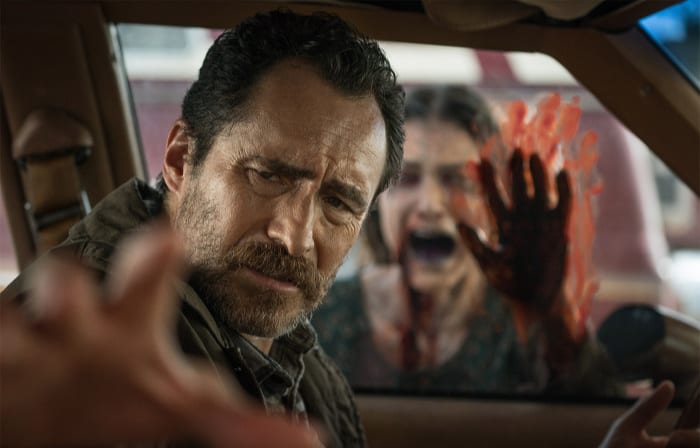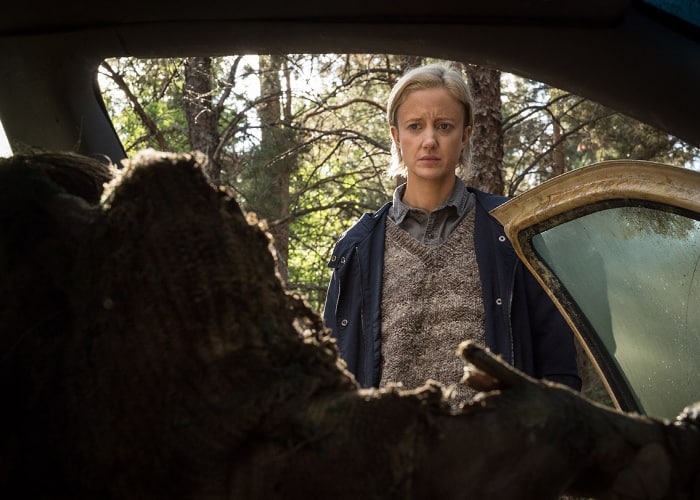We passed the head of [REDACTED] around the circle. Our fingers dragged across their face, probing sockets, tapping teeth, fondling the tongue, fingering ear lobes. Their cheek ruptured with a chunk of skull protruding into the air where it should not be. We tipped the head upside down and stared down into the neck. The flesh was torn, not sliced, conjuring in our imagination a most horrific end for this sorry cranium.
Days later, I would wake up next to my wife and not see her smiling face but this grotesque dead howl. Whether I heard the screech of a cat spewing from her throat or rather only considered the thought does not matter. The decapitated hunk of silicone I embraced in Canada a week previously clearly did its job. The next incarnation of The Grudge wants to embrace the fragility of the human body in ways that the previous American effort merely suggested but failed to capture due to PG-13 decency and box office aspirations. Director Nicolas Pesce carries no such civility. He’s here to scare the shit out of you.
Nearly two years ago, I and a platoon of other journalists were flown to Manitoba to visit the set. Sony took over the former St. John’s Cathedral Boys’ School for wayward children and transformed its basements into the evidence dungeon of a police precinct. Via monitors, we observed Andrea Riseborough navigate the maze of file cabinets and cheap trestle tables while her reality became infected by unseen apparitions. By this point in the adventure, her character, Detective Muldoon, has made contact with the Ju-On curse, and it’s working its way into tearing her life apart.
The grim pleasure of The Grudge is how its concept subverts the typical haunting narrative. The being with its hooks in your soul is not some wailing miserable spirt with delusions of justice or psychic closure. The Grudge is a malediction. Once you gain its attention, there is no escape that doesn’t involve your body bloodied, broken, boiled, or beaten. Your death is a mess designed to revolt the masses and elate the perverse. The Grudge must carry the brand of a hard R and deliver on it.
“Nick is not holding back,” explained Toby Lindala, the key special makeup effects designer and keeper of [REDACTED]’s head. “There’s a ridiculous amount of practical work and a ridiculous amount of blood.” He described the hard tumble that resulted in the decollation as a gargantuan splash of carnage. “[REDACTED] goes down four flights of stairs. On one flight, we split their head, and on another, we jam in their face. The amount of gore? We just painted the walls. We splattered their guts everywhere!”
Lindala caught me holding the head with a dumbfounded look of awe. “That bone is actually my buddy Lance’s gum,” he said. “It’s just Chiclets. They have a great hardshell with a softness on the inside. It really looks like shattered bone.” We all oohed, aahed, and took turns pressing in on the cheekbone.
The effects guru strives to unload a lifetime’s knowledge of Karo syrup and silicone meat but is always surprised when an opportunity such as this one comes knocking. “Someone will ask, ‘Can we split him in half and still have a PG-13 rating? No, fuck off!” Lindala shouted. “No, we can’t. Go make Bambi and fuck off.”

The director eased us back regarding his seemingly wanton barbarity. “It’s definitely a grisly movie,” Pesce admitted. “But it’s much more about the aftermath than the actual act of violence.” His camera is there to linger on the pieces but not necessarily how they became pieces. “I’ve always believed that an audience’s mind is going to make everything way scarier than anything I could do with makeup. This goes to the gore but also to the storytelling. This movie is about the audience putting pieces together and filling in the gaps themselves, whether it’s a story beat or violence.”
We lost ourselves in Lindala’s artistry of decay, marveling at his replication of death’s work. It’s that stunned reverence that Pesce is hoping to achieve with his Grudge. “We don’t really show any of the actual violence,” he said. “We show you what happens afterward and what it looks like when it’s all done.” Meaning, six or seven extra coats of red. “It allows you to fill in the gaps in your unique way, and make the story yourself, but also make that imagery for yourself. I always go back to Reservoir Dogs and the ear-cutting scene. It’s actually a pretty bad camera move away from the ear and back, but everyone always remembers seeing that ear get cut off, and that’s the best filmmaking you can do.”
Pesce’s process of relishing the grim consequences of The Grudge had a profoundly upsetting impact on his actors. According to Lindala, when [REDACTED] saw their body, they were shaken. “They got a little misty,” he said. “It really affected them.”
[REDACTED] was not alone. When we spoke to William Sadler, who plays another cop caught under the grip of The Grudge, he had just completed filming a sequence where his mental state unravels while documenting a collection of gruesome evidence. We watched him rattle a monologue into a tapedeck, “Every bone in her face was broken. Who could do that to a girl, a six-year-old girl? It’s gotta make sense.” He went through it several times, muttering to himself between takes, not dropping the character.

Finally, sitting in front of us, Sadler was still shaking. “Some scenes are easier than others,” he said. “I find more and more that it’s easier to just throw myself into it and whatever emotions start percolating up; let them happen.” Sadler opened himself to instinct and allowed the immediate energy to fuel the scene rather than forcing any intellectualization upon the moment. “I let myself get carried away by what’s happening in the scene.” The mechanics of the narrative will ultimately reveal the necessary sentiment.
Seeing him this way, I was a little taken aback. I was compelled to ask him if he was okay. “I’m still calming down,” he said. “Emotions are funny that way. They’re chemicals that get released in your head and your body. Once you’re doing two or three takes like that, ugh. You know what I mean? The hardest thing I think I’ve ever done in a film was that little scene in The Green Mile where I come upon Michael Clarke Duncan and he’s holding my two little girls. And I was a young father at the time we shot it. I hand a little girl about that age. Just to even go there was horrifying, but to spend a whole day going there, seeing them, it was awful. I couldn’t joke around with the crew or go have a snack at craft service. I couldn’t snap out of it. The scene required something else, and the thing that it required meant that I needed to keep one foot in it all day long.”
We can assume that Riseborough felt similarly. She refused to speak to us after she entered the headspace of Detective Muldoon. If we wanted to chat with her, we had to do so before the action started. Once she crossed into the realm of The Grudge, she would not come out until it’s over.
As such, she was not interested in discussing who her character is or how she relates to other roles in her filmography. “I’d rather speak about that after the film comes out,” she informed us. “At this stage, and I think this is always true for me, I’m still discovering exactly who she is. I always feel like playing a character is kind of like having self-awareness about who you are as a person.” Where we met her on the shoot, Riseborough simply didn’t have enough information to answer anything regarding her relationship with Detective Muldoon objectively. “As you get older in life, you have more and more self-awareness, and you’re kind of like, ‘Oh God, look, that’s a pattern,’ or ‘This is what I do,’ or ‘That’s so me.’ It’s the same with the character. When I stop playing a character, I sort of just intuitively know who they are.”

The character is not the reason to make the film. The filmmaker is. “At first, I didn’t have an idea of how we were going to rework this franchise from its first incarnation,” said Riseborough. “It was so dark and mysterious and kind of underground.” The original Ju-On is so exceptionally linked to Japanese culture and mythology. “In its second incarnation, it was completely different. It was the Hollywood version of that.” Riseborough saw zero reasons to continue in that direction.
“Nick had no interest in making it a genre film that was stunted by all the trappings of regular genre formula,” she said. “He just wanted to make a film. That’s the great strength that some of my favorite, very thrilling, and quite horrific films have. They’re beautifully acted, like The Shining. Nick sees it absolutely as a film. There’s no sense of us being here, making it a ‘horror movie.’ We’re all here making a film.”
Pesce is not trying to concoct an Americanized version of The Grudge. Remake, reboot, reimagining, whatever. The label doesn’t matter. “A lot of the late ’90s, early 2000 remakes were just trying to do the same thing as the J-horror movies, or at least using what became popular of J-horror movies,” described Pesce. “There’s definitely nods to that stuff, and we even go so far as to reference the original Japanese case that started the whole franchise, but we’re not trying to make a J-horror movie. I’m trying to do my own thing.”
Takashi Miike might be a better reference point for Pesce’s singular sensibilities. “I think that Audition is one of the greatest movies ever made,” he declared. “The way that Japanese horror kind of blends so many different tones. There’s some really fucked up shit! But then there’s also brief moments of levity and even humor. Particularly in the case of someone like Takashi Miike. You could be laughing at something horrifying and not quite understand how you’re supposed to feel. I like that incongruity and emotion in a movie like this one.”
His Grudge wants you to consider all the horrors that surround you. What happened in your bedroom before it was your bedroom? What’s happening in the bedroom across the way from your bedroom? Evil exists outside the linear. It continuously rages whether you make contact with it or not. If you do, all that you know is disturbed if not destroyed.
“Let’s make it feel more grounded,” said Pesce, “and more like real life and less of a high-concept world, by making it feel like this stuff is happening to your neighbor next door right now. There’s an immediacy to a lot of the J-horror stuff that does that, and I like that.” When death interrupts routine, it consumes everything. An exploded body at the bottom of the stairs becomes your whole world. It’s a curse, and it never relents. You might as well appreciate the artistry of it.
The Grudge spreads into theaters everywhere on January 3, 2020.
The post We Visited the Set of ‘The Grudge’ and Did Not Find a Remake in Process appeared first on Film School Rejects.


0 comments:
Post a Comment